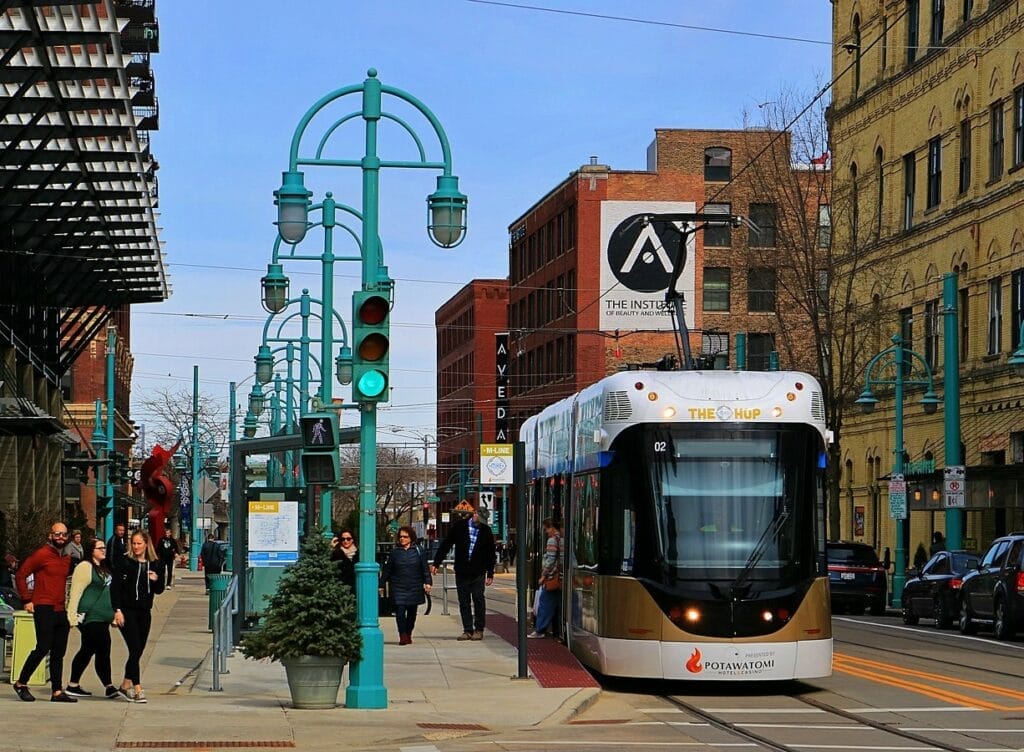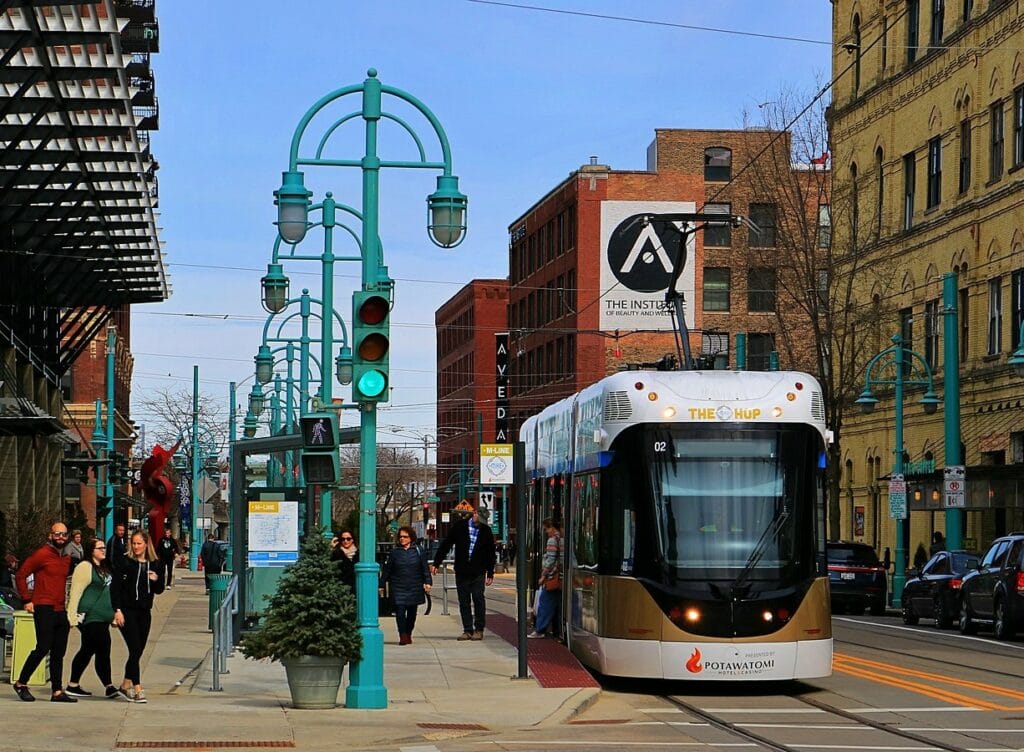This post originally appeared at https://www.badgerinstitute.org/free-milwaukee-streetcar-costing-over-5-million-annually/
Federal pandemic funds no longer available for operating costs
Facing a $5 million bill to run the free streetcar known as The Hop next year, Alderman Scott Spiker wondered if a huge increase in handing out parking tickets is the funding answer.

Department of Public Works officials say that is not the case.
“The parking ticket increase is not at all tied into The Hop,” Tiffany Shepherd, Marketing and Communications Officer for DPW, told the Badger Institute this week. “Also, The Hop’s operating budget is $4 million. We don’t see that as a deficit.”
According to the Department of Public Works budget, The Hop’s 2024 operating budget is $5.5 million.
The Department of Public Works is adamantly opposed to charging for the downtown Milwaukee streetcar, which cost $128 million to build. But at the end of this year, funding from the trillion-dollar American Rescue Plan Act of 2021 is going to dry up for The Hop.
Over the past three years, the American Rescue Plan Act supplied $7.7 million of the streetcar’s operating costs. In 2022, ARPA paid for 62.7% of its entire operating budget. That percentage dropped when DPW increased the operating budget by more than 20% to $5.3 million in 2023.
As the Badger Institute has reported over the past three years, Milwaukee and many other municipalities across the state and country treated CARES Act and ARPA — ostensibly COVID health emergency bills — as free money for every manner of pet project and new programs that will, going forward, need local taxpayer support to survive.
At a Finance and Personnel budget hearing on Oct. 10, City Budget Director Nic Kovac, who warned the city would face ARPA withdrawal back in December 2022, acknowledged The Hop would be $4 million short in 2025 without some other funding.
At that same hearing, DPW Commissioner Jerrel Krushke showed the committee revenue increases in another part of the proposed budget: $2 million from an increase in the number of parking citations and the cost of several of them; nearly $400,000 from a 59.1% increase in parking meter violations, to $35 from $22; and another $206,500 by ramping up dockless scooter fees by 81%.
Citation values, Krushke told the committee at the time, would be going up “across the board.”
At one point in the hearing, reviewed on video by the Badger Institute, Spiker asked Krushke if the parking ticket and fine program was related to the $4 million shortfall for The Hop.
“Is it being used to subsidize the streetcar? Because that was never the intent,” Spiker said. “I think that’s a fair question to ask, because there is a $4 million deficit.”
Spiker did not respond to an email asking him to elaborate on why he connected the two before this story was posted.
The department is asking that it be allowed to raise roughly $2.7 million through a variety of automobile parking fee increases, $2 million of it by writing tens of thousands more parking tickets in 2025.
Shepherd said the department expects the number of tickets to be written in 2025 to go up dramatically because after several years parking enforcement is once again at full staff. “We are only trying to crack down on behaviors that go against safety and access.”
Earlier this year, Portland made explicit the connection between autos and transit by passing increases in parking and vehicle registration increases to help bail out its light rail and streetcar.
Like Milwaukee, Portland and cities across the country, transit has been slow to rebound from the pandemic, transit and policy analyst Randal O’Toole told the Badger Institute. Always the least cost-effective way to move people around cities, rail and streetcars are more urban ornaments and moving monuments to the people who built them, O’Toole said.
What might seem to be the most obvious way to increase revenue — to charge a fare to ride — has been tried in some places and rejected, O’Toole says.
“Half of these transit programs charge no fares, because they know that if they charged people for it, ridership would drop by at least 50%,” O’Toole said.
It’s still unclear where operating funds for the The Hop will come from.
In Milwaukee, the number of riders, while slowly increasing coming out of COVID, was down by more than 38% in August, compared to the same month in 2019.
“We do not currently have any plans to start charging for The Hop,” Shepherd said. “In fact, we’ve seen other streetcar systems who went from free systems to a fare-based system eventually move back to the free system.”
Mark Lisheron is the Managing Editor of the Badger Institute.
Any use or reproduction of Badger Institute articles or photographs requires prior written permission. To request permission to post articles on a website or print copies for distribution, contact Badger Institute President Mike Nichols at mike@badgerinstitute.org or 262-389-8239.
Submit a comment
“*” indicates required fields
/* = 0;if(!is_postback){return;}var form_content = jQuery(this).contents().find(‘#gform_wrapper_21’);var is_confirmation = jQuery(this).contents().find(‘#gform_confirmation_wrapper_21’).length > 0;var is_redirect = contents.indexOf(‘gformRedirect(){‘) >= 0;var is_form = form_content.length > 0 && ! is_redirect && ! is_confirmation;var mt = parseInt(jQuery(‘html’).css(‘margin-top’), 10) + parseInt(jQuery(‘body’).css(‘margin-top’), 10) + 100;if(is_form){jQuery(‘#gform_wrapper_21’).html(form_content.html());if(form_content.hasClass(‘gform_validation_error’)){jQuery(‘#gform_wrapper_21’).addClass(‘gform_validation_error’);} else {jQuery(‘#gform_wrapper_21’).removeClass(‘gform_validation_error’);}setTimeout( function() { /* delay the scroll by 50 milliseconds to fix a bug in chrome */ jQuery(document).scrollTop(jQuery(‘#gform_wrapper_21’).offset().top – mt); }, 50 );if(window[‘gformInitDatepicker’]) {gformInitDatepicker();}if(window[‘gformInitPriceFields’]) {gformInitPriceFields();}var current_page = jQuery(‘#gform_source_page_number_21’).val();gformInitSpinner( 21, ‘https://e74sq7k37a8.exactdn.com/wp-content/plugins/gravityforms/images/spinner.svg’, true );jQuery(document).trigger(‘gform_page_loaded’, [21, current_page]);window[‘gf_submitting_21’] = false;}else if(!is_redirect){var confirmation_content = jQuery(this).contents().find(‘.GF_AJAX_POSTBACK’).html();if(!confirmation_content){confirmation_content = contents;}jQuery(‘#gform_wrapper_21’).replaceWith(confirmation_content);jQuery(document).scrollTop(jQuery(‘#gf_21’).offset().top – mt);jQuery(document).trigger(‘gform_confirmation_loaded’, [21]);window[‘gf_submitting_21’] = false;wp.a11y.speak(jQuery(‘#gform_confirmation_message_21’).text());}else{jQuery(‘#gform_21’).append(contents);if(window[‘gformRedirect’]) {gformRedirect();}}jQuery(document).trigger(“gform_pre_post_render”, [{ formId: “21”, currentPage: “current_page”, abort: function() { this.preventDefault(); } }]); if (event && event.defaultPrevented) { return; } const gformWrapperDiv = document.getElementById( “gform_wrapper_21” ); if ( gformWrapperDiv ) { const visibilitySpan = document.createElement( “span” ); visibilitySpan.id = “gform_visibility_test_21”; gformWrapperDiv.insertAdjacentElement( “afterend”, visibilitySpan ); } const visibilityTestDiv = document.getElementById( “gform_visibility_test_21” ); let postRenderFired = false; function triggerPostRender() { if ( postRenderFired ) { return; } postRenderFired = true; jQuery( document ).trigger( ‘gform_post_render’, [21, current_page] ); gform.utils.trigger( { event: ‘gform/postRender’, native: false, data: { formId: 21, currentPage: current_page } } ); if ( visibilityTestDiv ) { visibilityTestDiv.parentNode.removeChild( visibilityTestDiv ); } } function debounce( func, wait, immediate ) { var timeout; return function() { var context = this, args = arguments; var later = function() { timeout = null; if ( !immediate ) func.apply( context, args ); }; var callNow = immediate && !timeout; clearTimeout( timeout ); timeout = setTimeout( later, wait ); if ( callNow ) func.apply( context, args ); }; } const debouncedTriggerPostRender = debounce( function() { triggerPostRender(); }, 200 ); if ( visibilityTestDiv && visibilityTestDiv.offsetParent === null ) { const observer = new MutationObserver( ( mutations ) => { mutations.forEach( ( mutation ) => { if ( mutation.type === ‘attributes’ && visibilityTestDiv.offsetParent !== null ) { debouncedTriggerPostRender(); observer.disconnect(); } }); }); observer.observe( document.body, { attributes: true, childList: false, subtree: true, attributeFilter: [ ‘style’, ‘class’ ], }); } else { triggerPostRender(); } } );} );
/* ]]> */
The post “Free” Milwaukee streetcar costing over $5 million annually appeared first on Badger Institute.
